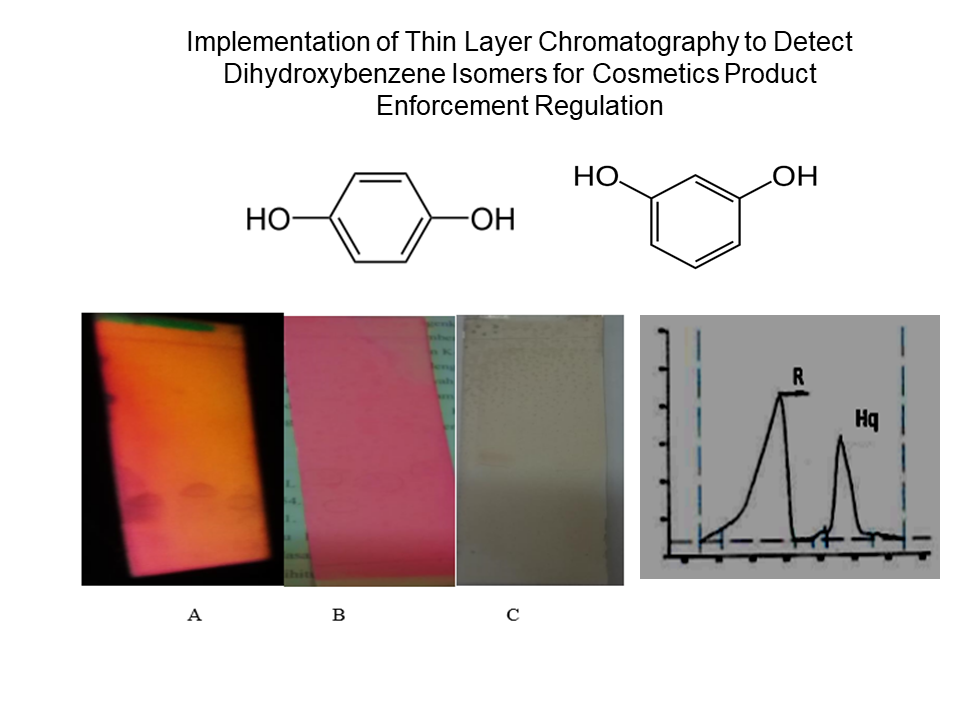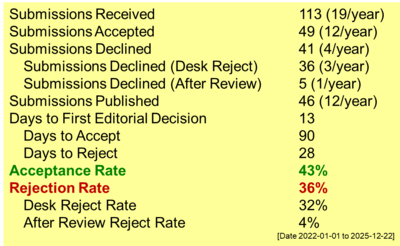Implementation of Thin Layer Chromatography to Detect Dihydroxybenzene Isomers for Cosmetic Product Regulatory Enforcement
DOI:
https://doi.org/10.55749/ijcs.v1i1.12Keywords:
TLC; Isomer; Hydroquinone; Law RegulationAbstract
Thin Layer Chromatography (TLC), used in forensic analysis, has many advantages: simple, cheap, and efficient. This study aimed to separate dihydroxybenzene isomers in whitening creams in the market and online shops using the BPOM label or not. Of the six eluent mixtures, this research used Toluene: Diethyl Ether: Acetic Acid with a ratio of 80:20:1 after optimization and validation test. In this case, the recovery percentages of resorcinol and hydroquinone were 51-66% and 80-87%. Of the 20 samples tested, 12 whitening creams were added with resorcinol, and 4 were added with hydroquinone. The addition of resorcinol and hydroquinone based on the regulation in Perka BPOM no 18 of 2015 was 5%. Furthermore, 2 out of 20 samples were added with hydroquinone within the regulated threshold, while the remaining 2% were accepted and the other six were undetected. In this case, adding hazardous substances has violated the rules of consumer protection laws and regulations.
References
Regulation of the Head of the Food and Drug Supervisory Agency of the Republic of Indonesia. 2013. Rule Number 34 Year 2013 concerning Amendments to the Regulation of the Head of the Food and Drug Supervisory Agency Number Hk.03.1.23.12.10.11983 of 2010 concerning Criteria and Procedures for Submitting Cosmetic Notifications.
Pérez-Rueda, E., & Collado-Vides, J. 2000. The repertoire of DNA-binding transcriptional regulators in Escherichia coli K-12. Nucleic Acids Res. 28(8). 1838-1847. doi: 10.1093/nar/28.8.1838. https://doi.org/10.1093/nar/28.8.1838
Sari, S.D., Budiono, A., & Yulianie, D.A. 2020. Legal protection for skincare users that does not have a production license review of the consumer protection act. Media Keadilan: Jurnal Ilmu Hukum. 11(2). 156-168. doi: 10.31764/jmk.v11i2.3256. https://doi.org/10.31764/jmk.v11i2.3256
Astuti, D.W., Prasetya, H.R., & Irsalina, D. 2016. Identification in Whitening Creams Sold at Minimarkets in Minomartini, Yogyakarta. Journal AMS. 2(1). 13-19. https://doi.org/10.19184/ams.v2i1.1859
De, A.K., Chowdhury, P.P., & Chattapadhyay, S. 2014. Quantitative analysis of resorcinol from marketed hair tonic using liquid chromatographic technique. Int. Sch. Res. Notices. 2014(632591). 1-5. doi: 10.1155/2014/632591. https://doi.org/10.1155/2014/632591
Aragó, M., Ariño, C., Dago, À., Díaz-Cruz, J. M., & Esteban, M. 2016. Simultaneous determination of hydroquinone, catechol and resorcinol by voltammetry using graphene screen-printed electrodes and partial least squares calibration. Talanta. 160. 138-143. doi: 10.1016/j.talanta.2016.07.007. https://doi.org/10.1016/j.talanta.2016.07.007
Yunianto, E.P., & Anggoro, Y. 2021. Understanding Illegal Cosmetic Circulation in Indonesian Online Marketplace through Problem Analysis Triangle. JICP. 4(3), 34-41. doi: 10.32535/jicp.v4i3.1297. https://doi.org/10.32535/jicp.v4i3.1297
Arifiyana, D. Harjanti, Y.S. & Ebtavanny, T.G. 2019. Quantitative Analysis of Hydroquinone on Whitening Cream Cosmetic Products Circulating in Central Surabaya and North Surabaya using UV-Vis Spectrophotometry Method. Akta Kimindo. 4(2). 107-117. doi: 10.12962/j25493736.v4i2.5532. https://doi.org/10.12962/j25493736.v4i2.5532
Wang, Y.H., Avonto, C., Avula, B., Wang, M., Rua, D., & Khan, I.A. 2015. Quantitative determination of α-arbutin, β-arbutin, kojic acid, nicotinamide, hydroquinone, resorcinol, 4-methoxyphenol, 4-ethoxyphenol, and ascorbic acid from skin whitening products by HPLC-UV. J. AOAC Int. 98(1). 5-12. doi: 10.5740/jaoacint.14-123. https://doi.org/10.5740/jaoacint.14-123
Kirkwood, K., & David Jackson, S. 2020. Hydrogenation and hydrodeoxygenation of oxygen-substituted aromatics over rh/silica: Catechol, resorcinol and hydroquinone. Catalysts, 10(5). 1-17. doi: 10.3390/catal10050584. https://doi.org/10.3390/catal10050584
Akyol, A., Can, O.T., Bayramoglu, M. 2015. Treatment of hydroquinone by photochemical oxidation and electrocoagulation combined process. J. Water Process Eng. 8. 45-54. doi: 10.1016/j.jwpe.2015.09.001. https://doi.org/10.1016/j.jwpe.2015.09.001
Chen, Y.M., & Chavin, W.A.L.T.E.R. 1976. Hydroquinone activation and inhibition of skin tyrosinase. Pigment Cell. 3,.105-112.
Engasser, P. G. 1984. Ochronosis caused by bleaching creams. J. Am. Acad. Dermatol. 10(6).1072-1073. doi: 10.1016/s0190-9622(84)80351-5. https://doi.org/10.1016/S0190-9622(84)80351-5
Bellmaine, S., Schnellbaecher, A., & Zimmer, A. 2020. Reactivity and degradation products of tryptophan in solution and proteins. Free Radic. Biol. Med.. 160. 696-718. doi: 10.1016/j.freeradbiomed.2020.09.002. https://doi.org/10.1016/j.freeradbiomed.2020.09.002
Hull, P.R., & Procter, P.R. 1990. The melanocyte: an essential link in hydroquinone-induced ochronosis. J. Am. Acad. Dermatol. 22(3). 529-531. doi: 10.1016/S0190-9622(08)80401-X. https://doi.org/10.1016/S0190-9622(08)80401-X
Pillaiyar, T., Manickam, M., & Namasivayam, V. 2017. Skin whitening agents: Medicinal chemistry perspective of tyrosinase inhibitors. J. Enzyme Inhib. Med. Chem. 32(1). 403-425. doi: 10.1080/14756366.2016.1256882. https://doi.org/10.1080/14756366.2016.1256882
Levin, C.Y., & Maibach, H. 2001. Exogenous ochronosis. Am. J. Clin. Dermatol. 2(4), 213-217. doi: 10.2165/00128071-200102040-00002. https://doi.org/10.2165/00128071-200102040-00002
Qian, W., Liu, W., Zhu, D., Cao, Y., Tang, A., Gong, G., & Su, H. 2020. Natural skin‑whitening compounds for the treatment of melanogenesis. Exp. Ther. Med. 20(1) 173-185. doi: 10.3892/etm.2020.8687. https://doi.org/10.3892/etm.2020.8687
Kang, M., Park, S. H., Oh, S. W., Lee, S. E., Yoo, J. A., Nho, Y. H., Lee, S., Han, B. S., Cho, J. Y., & Leea, J. 2018. Anti-melanogenic effects of resorcinol are mediated by suppression of cAMP signaling and activation of p38 MAPK signaling. Biosci. Biotechnol. Biochem. 82(7). 1188-1196. doi: 110.1080/09168451.2018.1459176. https://doi.org/10.1080/09168451.2018.1459176

Downloads
Published
How to Cite
Issue
Section
License
Copyright (c) 2022 Indonesian Journal of Chemical Studies

This work is licensed under a Creative Commons Attribution-ShareAlike 4.0 International License.






















